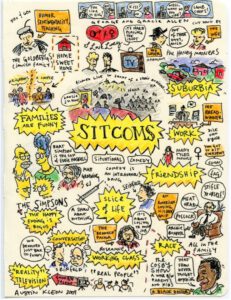How many hours have you already spent looking at a screen today? Nowadays, the universal answer to this question seems to be “too much.” As the internet becomes more deeply ingrained in every aspect of our lives, it gets trickier and trickier to find responsible ways of engaging with the online world without getting lost in it. This issue became even more challenging for many people during the pandemic. Researchers at the University of California, San Francisco, for example, found that young people now spend an average of 7.7 hours of their daily free time in front of screens – twice as much as they did pre-COVID. Why is the internet so wickedly tempting, and how can we establish healthier digital habits?
Tag Archives: Pandemic
Teen Nonprofits Find Solutions during Covid-19 Pandemic

In the middle of a Covid-19 lockdown packed with distance learning difficulties, teachers at the Schmalkalden Elementary School in Thuringia, Germany, learned that the digital tool they had been using didn’t meet the country’s strict data-privacy restrictions. “A parent at the school asked whether I could develop a program from scratch over the weekend,” said Mathias Wickenhagen, a 20-year-old programmer in the neighborhood. “And I did.”
All the Stories That We (Were) Told

Life writing – which includes a wide spectrum of sub-genres such as (auto)biography, memoir, letter, diary, (digital) life stories, and oral histories – has a long tradition in the U.S. and is becoming more and more popular all over the world. An abundance of artifacts compiled by famous, semi-famous, and not-at-all-famous people fill public libraries, private bookshelves, research centers, social media, hard drives, and websites. And that’s actually not even surprising since writing and/or talking about ourselves is a deeply rooted cultural practice and comes very naturally to most human beings. We do it all the time: We tell a significant someone how our day was, we put together our résumé when applying for a new job, we talk about childhood memories with siblings or a close friend. However, talking and writing about ourselves in an academic context and, to boot, in a foreign language is a completely different story.
505 Hours and 45 Minutes of Comfort in Times of Uncertainty

505 hours and 45 minutes – that’s how long it takes to watch all of my favorite TV shows. Ever since the first nationwide lockdown began in Germany last March, I’ve been doing some serious re-watching. Among the shows I’ve been binging is the entire season of Friends (10), Parks and Recreation (7), The Office (9), Modern Family (10), How I Met Your Mother (9), New Girl (7), and Brooklyn 99 (8) – and some more than once.
According to The Huffington Post, watching something familiar triggers a feeling of nostalgia, which has a positive effect on your mental health. For instance, your mind may reconnect with the setting, the people you were with, or the feelings you had when you initially watched a certain episode. In my case, re-watching TV shows transports me back to the time before the pandemic.
I’ve always been someone to watch a good TV show multiple times or read a good book more than once. At this point, however, the rate at which I re-watch a film or show has reached a new height. Why is that? And what do all those TV shows have in common, apart from being successful American sitcoms?
My Girls, Our Girls, and the Women Before Us
“It is my honor to be here, to stand on the shoulders of those who came before,” Kamala Harris, the first female, the first black, the first Asian American Vice-President of the U.S.A. proudly said in her first address to the nation on inauguration day. Her tone is optimistic, her goals are ambitious, and her energy seems unlimited.
https://www.youtube.com/watch?v=QJyV-1VwqpE&feature=emb_logo
It is true, we all are standing on the shoulders of those who came before, all the women who prepared the way for our progress, our achievements. And there has been quite a bit of progress as Carol Dyhouse, a social historian at the University of Sussex, describes in her new book, Love Lives: From Cinderella to Frozen. The title is a bit misleading. Though myths, fairy tales, and popular culture tropes still influence us, Dyhouse outlines how women in the western world have abandoned the restrictions of domestic life since the 1950s and gradually, though often painfully, have claimed access to education and the professional world. A long path it has been to self-determination and economic independence.
But even now the question remains: Have we made enough progress? Because I do worry about “my girls” these days, as Michelle Obama describes them. I worry about “my boys,” too, but this is a blog post to remind ourselves of International Women’s Day and Women’s History Month. Both encourage us to reflect on those who came before, but also on those to whom we pass the baton, whose legs we steady on our shoulders.







